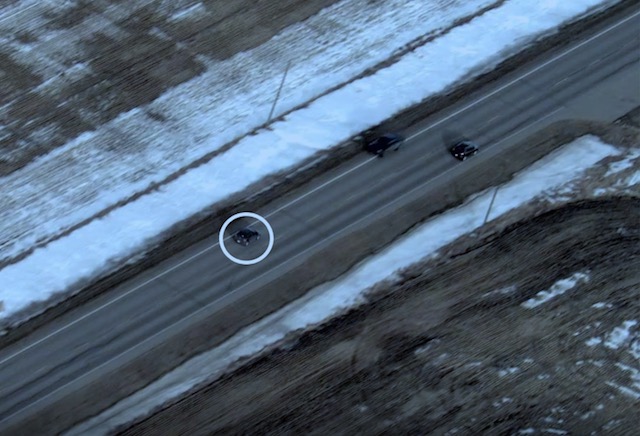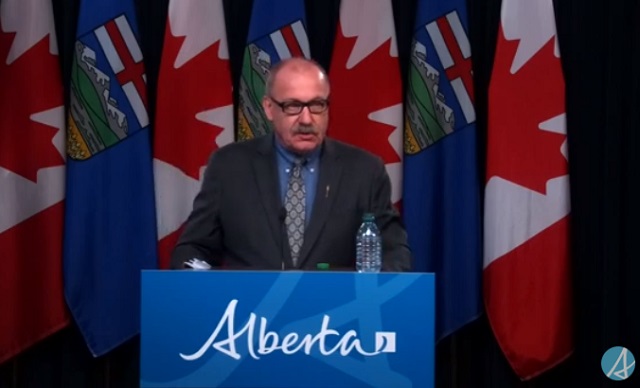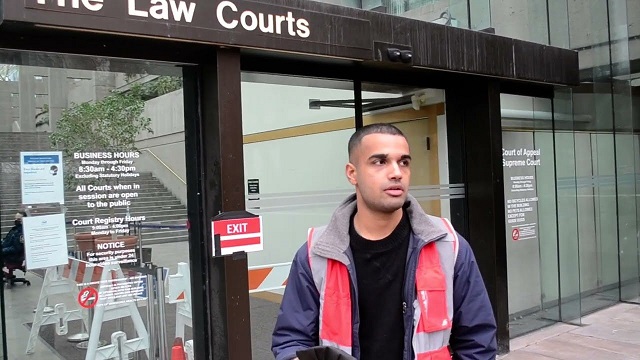Alberta
Investigation reveals terrifying life and death situation faced by police officer forced to shoot attacking suspect

Figure 1 – HAWCS video showing the AP (circled in white) driving on the wrong side of the highway and forcing a vehicle off the road.
News release from the Alberta Serious Incident Response Team (ASIRT)
ASIRT’s Investigation
ASIRT’s investigation was comprehensive and thorough, conducted using current investigative protocols, and in accordance with the principles of major case management. Investigators interviewed all relevant police and civilian witnesses, and secured and analyzed all relevant radio communications.
This incident was captured on video by a Calgary Police Service (CPS) helicopter air watch community safety (HAWCS) helicopter. Some of the incident was also captured on cameras in the RCMP vehicles. These videos provide objective evidence and are therefore extremely valuable to ASIRT investigations.
Circumstances Surrounding the Incident
At approximately 1:50 p.m. on February 12, 2023, CPS received a 9-1-1 call about the affected person (AP). The caller was concerned that she was suicidal. RCMP officers responded to an area east of Calgary, and a CPS helicopter went to assist.
At 3:35 p.m., the witness officer (WO) located the AP in her vehicle on the side of Highway 564. The AP sped off and the WO followed. The CPS helicopter located the AP and the WO shortly after and began to record the incident.
The AP was driving extremely fast, including at speeds of over 175 km/h, and often on the wrong side of the highway. There were other vehicles on the road at that time. The AP drove through a stop sign at the intersection of Highways 564 and 9 and was briefly launched into the air due to her speed and the elevated intersection. The AP continued to drive on the wrong side of the highway (Figure 1).
At Highway 21, the AP turned around and travelled back west. She then briefly went off the road and into the ditch. At 3:51 p.m., the SO used a tire deflation device that punctured some of the AP’s tires. The AP then came to a stop and, at 3:52 p.m., the SO stopped his marked police vehicle behind the AP.
As the SO stopped, the AP exited her vehicle. She had a knife in her left hand and a beer in her right (Figure 2).
Figure 2 – The SO’s vehicle video showing the AP with a knife in her left hand.
The SO can be heard to yell, “drop the knife!” on the police vehicle video. The AP took a few steps toward the SO and then began to run toward him (Figure 3).
As she was running, the AP said, “I’m going to fucking kill you!” The SO said “drop the knife” repeatedly. The SO moved backwards and drew a handgun and then a conductive energy weapon (CEW).
Figure 3 – HAWCS video showing the AP running at the SO.
The AP continued to run at the SO until she reached the rear of his police vehicle, when she turned and attempted to go into the police vehicle (Figure 4).
Figure 4 – HAWCS video showing the AP entering the SO’s police vehicle.
The SO ran back to his vehicle and used his CEW on the AP. The AP then turned and ran at the SO again (Figure 5).
Figure 5 – HAWCS video showing the AP running at the SO again.
The AP again said, “I’m going to fucking kill you!” The SO then fired seven shots at 3:53 p.m., hitting the AP and causing her to fall to the road and drop her knife (Figure 6).
The SO approached the AP and kicked away the knife. The SO began to assess the AP, and other officers arrived within one minute to provide first aid to the AP. At 4:06 p.m., emergency medical services arrived and assumed care of the AP. An air ambulance was then used to transport the AP to hospital.
The AP had seven gunshot wounds to her chest, midsection, arms, and legs. She required surgeries and stayed in the hospital for some time.
Figure 6 – HAWCS video showing the AP falling to the road after being shot by the SO.
A knife was found in the ditch near the AP (Figure 7).
Figure 7 – Knife found in ditch near the AP.
Civilian Witnesses
ASIRT investigators interviewed or reviewed interviews with eight individuals who saw the incident or the AP driving that day. Their evidence was generally consistent with the above.
Affected Person’s (AP) Statement
ASIRT investigators interviewed the AP on February 28, 2023. She told them that she was suicidal on February 12. Initially she planned to find a semi-truck to run her over.
After the WO had stopped chasing her, she turned around to reengage with the police. She drove over the tire deflation device and then pulled over. Before she left her vehicle, she grabbed a knife because she thought that the police would not shoot her unless she had something. She left her vehicle and walked fast toward the SO, saying something like “just hit me” or “shoot me.”
The SO used his CEW on her but she pushed through the pain and continued to move toward the SO. She said something like “fucking hit me you little bitch” and the SO shot her. She continued to approach the SO and he then jumped on her, taking her to the ground and injuring her leg.
The police officers provided her with medical attention immediately. She asked them to let her die.
The AP said it was her goal to die and she did not want to hurt any police officers.
Subject Officer’s (SO) Statement
On May 1, 2023, ASIRT investigators interviewed the SO. He provided a written statement and then answered questions after reading it. Subject officers, like anyone being investigated for a criminal offence, can rely on their right to silence, and do not have to speak to ASIRT.
The SO’s evidence was consistent with the video evidence and provided some insight into his view of the incident. The SO did not hear what the AP said when she was running at him. After he shot her, he heard her say things like “let me die” and “you never help me.”
When the AP was running at the SO for the second time, he recognized that he could only run backwards for so long before tripping or falling and being at risk. He feared that the AP would cause him grievous bodily harm or death and fired at the AP until she stopped advancing.
Analysis
Section 25 Generally
Under s. 25 of the Criminal Code, police officers are permitted to use as much force as is necessary for execution of their duties. Where this force is intended or is likely to cause death or grievous bodily harm, the officer must believe on reasonable grounds that the force is necessary for the self-preservation of the officer or preservation of anyone under that officer’s protection. The force used here, discharging a firearm repeatedly at a person, was clearly intended or likely to cause death or grievous bodily harm. The subject officer therefore must have believed on reasonable grounds that the force he used was necessary for his self-preservation or the preservation of another person under his protection. Another person can include other police officers. For the defence provided by s. 25 to apply to the actions of an officer, the officer must be required or authorized by law to perform the action in the administration or enforcement of the law, must have acted on reasonable grounds in performing the action, and must not have used unnecessary force.
All uses of force by police must also be proportionate, necessary, and reasonable.
Proportionality requires balancing a use of force with the action or threat to which it responds. This is codified in the requirement under s. 25(3), which states that where a force is intended or is likely to cause death or grievous bodily harm, the officer must believe on reasonable grounds that the force is necessary for the self-preservation of the officer or preservation of anyone under that officer’s protection. An action that represents a risk to preservation of life is a serious one, and only in such circumstances can uses of force that are likely to cause death or grievous bodily harm be employed.
Necessity requires that there are not reasonable alternatives to the use of force that also accomplish the same goal, which in this situation is the preservation of the life of the officer or of another person under his protection. These alternatives can include no action at all. An analysis of police actions must recognize the dynamic situations in which officers often find themselves, and such analysis should not expect police officers to weigh alternatives in real time in the same way they can later be scrutinized in a stress- free environment.
Reasonableness looks at the use of force and the situation as a whole from an objective viewpoint. Police actions are not to be judged on a standard of perfection, but on a standard of reasonableness.
Section 25 Applied
The SO was assisting on a call that evolved as time went on. It started as a welfare check, became a serious dangerous driving investigation, and ended with dealing with an assaultive person. The SO’s actions throughout were required or authorized by law and he acted on reasonable grounds.
The first stage in assessing whether the force he used was excessive is proportionality. The AP was running at the SO with a knife, which could affect the SO’s self-preservation. He responded with his firearm, which was intended or likely to cause death or grievous bodily harm. These two forces are proportionate.
The necessity element of the assessment recognizes the dynamic nature of incidents such as this. Here, the AP ran at the SO suddenly, which created a serious situation. The SO recognized at this point that he could attempt to deescalate the situation by moving away from the AP. However, the AP then attempted to get into his police vehicle, which would have created a profoundly serious danger to him and other users of the highway. He then used his CEW, which was not effective. The AP began running at him again. With the threat still present and having exhausted reasonable alternatives, it was necessary for the SO to fire at the AP at that time.
The final element, reasonableness, looks at the incident overall. The SO conducted himself carefully and showed restraint at the beginning of the incident. His actions were reasonable.
As a result, the defence under s. 25 is likely to apply to the SO.
Section 34 Generally
A police officer also has the same protections for the defence of person under s. 34 of the Criminal Code as any other person. This section provides that a person does not commit an offence if they believe on reasonable grounds that force is being used or threatened against them or another person, if they act to defend themselves or another person from this force or threat, and if the act is reasonable in the circumstances. In order for the act to be reasonable in the circumstances, the relevant circumstances of the individuals involved and the act must be considered. Section 34(2) provides a non-exhaustive list of factors to be considered to determine if the act was reasonable in the circumstances:
(a) the nature of the force or threat;
(b) the extent to which the use of force was imminent and whether there were other means available to respond to the potential use of force;
(c) the person’s role in the incident;
(d) whether any party to the incident used or threatened to use a weapon;
(e) the size, age, gender and physical capabilities of the parties to the incident;
(f) the nature, duration and history of any relationship between the parties to the incident, including any prior use or threat of force and the nature of that force or threat;
(f.1) any history of interaction or communication between the parties to the incident;
(g) the nature and proportionality of the person’s response to the use or threat of force; and
(h) whether the act committed was in response to a use or threat of force that the person knew was lawful.
The analysis under s. 34 for the actions of a police officer often overlaps considerably with the analysis of the same actions under s. 25.
Section 34 Applied
For the same reasons as under s. 25, this defence is likely to apply to the SO. The AP was running at him with a knife and, like anyone would be, he was entitled to use force to repel her.
Conclusion
The AP was suicidal on February 12, 2023. She initially intended to drive into a semi- truck, but then decided to force police to shoot her. She did this by running at the SO with a knife in her hand. The SO was justified in responding with his firearm.
The defences available to the SO under s. 25 and s. 34 are likely to apply. As a result, there are no reasonable grounds to believe that an offence was committed.
Alberta
Former senior financial advisor charged with embezzling millions from Red Deer area residents

News release from Alberta RCMP
Former senior financial advisor charged for misappropriating nearly $5 million from clients
On April 4, 2024, the RCMP’s Provincial Financial Crime Team charged a Calgary resident for fraud-related offences after embezzling millions of dollars from his clients while serving as a senior financial advisor.
Following a thorough investigation, the accused is alleged to have fraudulently withdrawn funds from client accounts and deposited them into bank accounts he personally controlled. A total of sixteen victims were identified in the Red Deer area and suffered a combined loss of nearly $5 million.
Marc St. Pierre, 52, a resident of Calgary, was arrested and charged with:
- Fraud over $5,000 contrary to section 380(1)(a) of the Criminal Code; and,
- Theft over $5,000 contrary to section 344(a) of the Criminal Code.
St. Pierre is scheduled to appear in Red Deer Provincial Court on May 14, 2024.
“The ability for financial advisors to leverage their position to conduct frauds and investment scams represents a significant risk to the integrity of Alberta’s financial institutions. The investigation serves as an important reminder for all banking clients to regularly check their accounts for any suspicious activity and to report it to their bank’s fraud prevention team.”
- Sgt. John Lamming, Provincial Financial Crime Team
The Provincial Financial Crime Team is a specialized unit that conducts investigations relating to multi-jurisdictional serious fraud, investments scams and corruption.
Alberta
Political parties will be part of municipal elections in Edmonton and Calgary pilot projects

Strengthening Alberta’s local elections
Alberta’s government is introducing legislation to ensure Albertans can rely on transparent, free and fair elections, and municipally-elected officials have clearer accountability measures.
In a democratic society, Albertans expect their local elections to be free and fair, and their elected officials to be held to account by clear rules that govern their local councils. The Municipal Affairs Statutes Amendment Act proposes amendments to the Local Authorities Election Act (LAEA) and the Municipal Government Act (MGA) to add greater transparency to local election processes and ensure local councils and elected officials continue to remain accountable to the citizens who elected them.
“Our government is committed to strengthening Albertans’ trust in their local governments and the democratic process that elects local leaders. The changes we are making increase transparency for Alberta voters and provide surety their votes will be counted accurately. We know how important local democracy is to Albertans, and we will work with local authorities to protect and enhance the integrity of local elections.”
Local Authorities Election Act
Albertans expect free and fair elections and that’s why it’s important we strengthen the rules that govern local elections. To strengthen public trust in local elections, Alberta’s government will eliminate the use of electronic tabulators and other automated voting machines. All Albertans should be able to trust the methods and results of local elections; requiring all ballots to be counted by hand, clarifying rules and streamlining processes for scrutineers will provide voters greater assurance in the integrity of the results.
All eligible Albertans should be able to vote in local elections without impediment. Alberta’s government will limit the barriers for eligible voters to cast a ballot by expanding the use of special ballots. Currently, special ballots can only be requested for very specific reasons, including physical disability, absence from the municipality, or for municipal election workers. By expanding the use of special ballots, the government is encouraging more voter participation.
Amendments in the Municipal Affairs Statutes Amendment Act would increase transparency in local elections by enabling political parties at the local level. Political parties would be enabled in a pilot project for Edmonton and Calgary. The act will not require candidates to join a political party in order to run for a local or municipal office, but will create the opportunity to do so.
In addition, proposed changes to the Local Authorities Election Act would allow municipalities the option to require criminal record checks for local candidates, thus increasing transparency and trust in candidates who may go on to become elected officials.
Municipal Government Act
The role of an elected official is one with tremendous responsibility and expectations. Changes proposed to the Municipal Government Act (MGA) will strengthen the accountability of locally elected officials and councils. These include requiring mandatory orientation training for councillors, allowing elected officials to recuse themselves for real or perceived conflicts of interest without third-party review and requiring a councillor’s seat to become vacant upon disqualification.
If passed, the Municipal Affairs Statutes Amendment Act will also unlock new tools to build affordable and attainable housing across Alberta. Proposed amendments under the MGA would also create more options for municipalities to accelerate housing developments in their communities. Options include:
- Exempting non-profit, subsidized affordable housing from both municipal and education property taxes;
- Requiring municipalities to offer digital participation for public hearings about planning and development, and restricting municipalities from holding extra public hearings that are not already required by legislation; and
- Enabling municipalities to offer multi-year residential property tax exemptions.
Municipal Affairs will engage municipalities and other partners over the coming months to hear perspectives and gather feedback to help develop regulations.
Quick facts
- The LAEA establishes the framework for the conduct of elections in Alberta municipalities, school divisions, irrigation districts and Metis Settlements.
- The MGA establishes the rules governing the conduct of local elected officials once on council, as well as the overall administration and operation of municipal authorities in Alberta, including any policy those authorities may wish to implement.
Related information
-

 COVID-1922 hours ago
COVID-1922 hours agoPfizer reportedly withheld presence of cancer-linked DNA in COVID jabs from FDA, Health Canada
-

 Censorship Industrial Complex1 day ago
Censorship Industrial Complex1 day agoJordan Peterson, Canadian lawyer warn of ‘totalitarian’ impact of Trudeau’s ‘Online Harms’ bill
-

 Alberta2 days ago
Alberta2 days agoAlberta rejects unconstitutional cap on plastic production
-

 Alberta2 days ago
Alberta2 days agoAlberta official reveals ‘almost all’ wildfires in province this year have been started by humans
-

 Bruce Dowbiggin2 days ago
Bruce Dowbiggin2 days agoCome For The Graduate Studies, Stay For The Revolution
-

 Business2 days ago
Business2 days agoTaxpayers criticize Trudeau and Ford for Honda deal
-

 Alberta2 days ago
Alberta2 days agoPolitical parties will be part of municipal elections in Edmonton and Calgary pilot projects
-

 Censorship Industrial Complex2 days ago
Censorship Industrial Complex2 days agoAustralian politicians attack Elon Musk for refusing to remove video of Orthodox bishop’s stabbing






